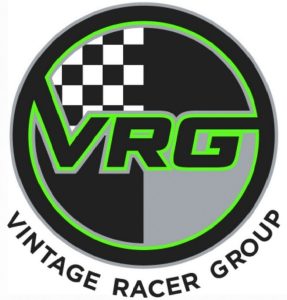
Rev 2.1 5-6-2024
VRG Flag Rules
Download a PDF copy of the flag rules here.
The VRG Board of Directors has voted to adopt the SCCA flag rules (GCR Section 6.1.1) as the official flag rules for all VRG events. There are several reasons for this decision; the most important to establish consistency from event to event for the meanings of the flags and what each driver is expected to do when they are shown. These flag rules have been in effect for many years and have stood the test of time with very few changes. The majority of our drivers are familiar with them as are the corner workers that marshal our events. These rules are published here for our drivers’ convenience and are also available on-line from the SCCA web site. The text in italics after the descriptions of some of the flags are clarifications from the VRG Board or from the SCCA Flagging & Communications Manual that do not appear in the GCR.
Please familiarize yourself with the flags. As a driver, you are expected to know and understand the meaning of each flag and respond appropriately.
Meaning of Each Flag
A. GREEN FLAG (Solid Green)

When displayed, the green flag indicates that the course is clear, and that racing is underway. The green flag is ordinarily shown only by the Starter. Note: Racing starts as soon as the green flag is shown at Start. Drivers needn’t wait to cross the Start/Finish line to begin racing.
B. YELLOW FLAG (Solid Yellow)

“Waving on the paving; standing in the grass”
STANDING YELLOW – Take care, Danger, Slow Down – NO PASSING FROM THE FLAG until past the next staffed flag station NOT DISPLAYING a yellow flag.
Note: Typically, the stationary or standing yellow flag lets the drivers know that there is no obstruction on the racing surface, however there is something in a hazardous area. This could be a car just off course, an emergency vehicle attending to a disabled vehicle, a marshal that is exposed in a target area. A standing yellow flag may be displayed during the first lap of each race group’s first session of the day to indicate the location of the flagging stations. In this case the no passing rule still applies.
WAVED – Great Danger, Slow Down, be prepared to stop – NO PASSING FROM THE FLAG until past the next staffed flag station NOT DISPLAYING a yellow flag.
Note: The waving yellow flag tells the drivers that there is an obstruction on the racing surface. It prepares them to take necessary evasive action to avoid compounding the incident.
DOUBLE YELLOW, DISPLAYED AT ALL STATIONS – Indicates the entire course is under yellow (full course yellow). All stations will display double yellow flags for all pace and safety car laps. SLOW DOWN, NO PASSING. However, cars may carefully pass emergency vehicles and other cars that are disabled or off pace.
Note: The GCR does say a double yellow will be displayed at ALL stations, but if a station has an incident on the track then one of the two yellows shall be waved.
NOTE: A driver may encounter several flags before reaching the emergency area. The requirements are still the same: SLOW DOWN, NO PASSING.
C. BLUE FLAG (Blue with Diagonal Yellow Stripe)

Another competitor is following very closely or is trying to overtake. This flag may be displayed standing or waving, depending upon the speed differential.
Note: This flag can be very important when groups of cars with varying levels of performance potential are on course at the same time; also when leaders in a race begin lapping the slower cars in the field. All drivers have a responsibility to keep an eye on their mirrors. You must be aware of the cars that may be about to pass you. If the car behind you is clearly a faster car that is going to pass you, or you simply desire the car to pass you, point to the side on which you want to be passed. Do not make sudden moves of your race line – it is imperative that you maintain a predictable race line at all times and the overtaking car coming behind you can count on you being predictable. Note that the slower car is not required to “get out of the way” of the faster car. It is the responsibility of the overtaking car to execute a safe pass.
D. SURFACE CONDITION (Yellow with Vertical Red Stripes)

Take care. A slippery condition exists, or debris is present on the racing surface. This flag is displayed standing.
Note: The surface flag is displayed for debris that can be driven over; for larger debris on track a waving yellow would be shown.
E. WHITE FLAG (Solid White)

Caution and take care for a slow-moving race car, ambulance or other emergency vehicle on the racing surface. The standing white flag is displayed for two flag stations prior to the vehicle in
question. In addition, a standing white flag may be displayed during the first lap of each race group’s first session of the day to indicate the location of the flagging stations.
F. BLACK FLAG

CLOSED BLACK FLAG (Furled) – Pointed or shaken at an individual car from the Starter’s stand (optionally, accompanied by a number board indicating the car number): WARNING for driving in an unsafe and/or improper manner. Continued unsafe and/or improper driving will result in an OPEN BLACK FLAG. Note: The driver should acknowledge this flag but is not required to come to the pits at this time.
OPEN BLACK – Displayed from the Starter’s stand, maybe shown with a number board, indicating the car number: Proceed directly to the pits and the location designated by the Chief Steward or event chairman for consultation with Officials. DO NOT TAKE ANOTHER LAP.
NOTE: The driver should acknowledge this flag when shown.
NOTE: This flag and number board may also be displayed at station(s) elsewhere on the course (designated black flag station).
OPEN BLACK, DISPLAYED AT ALL STATIONS (WITH ROCKING MOTION) – The session has been stopped; all cars must stop racing, no passing, and proceed directly and immediately to the pits, exercising extreme caution. This flag may be displayed with an ‘ALL’ sign at the Starter’s stand and the sign may also be shown at station(s) elsewhere on the course.
G. MECHANICAL BLACK FLAG (Black with Orange Ball)

Displayed from the Starter’s stand with a number board indicating the car number. There is a mechanical problem with the car. Proceed directly to your pit or the location designated by the Chief Steward or event chair. DO NOT TAKE ANOTHER LAP.
Note: This flag and number board may also be displayed at station(s) elsewhere on the course (designated black flag station). The driver should acknowledge this flag when shown.
H. CHECKERED FLAG (Black and White Checks)

Displayed at Finish to indicate that the session is finished. Continue cautiously to the pits.
Note: The checkered flag may be displayed at a station other than Start/Finish during practice sessions only at the discretion of the stewards.
I. RED FLAG (Solid Red)

Displayed at each station and on the Starter’s stand – EXTREME DANGER – THE SESSION HAS BEEN STOPPED. Check your mirrors and come to a prompt, controlled stop at the side of the race track on the pavement (preferably before and within sight of a staffed station). When released by an official, proceed cautiously to the pits. Once a red flag has been displayed, it will not
be withdrawn until all cars have come to a stop. A “black flag all” will be used to return cars to the pits.
Note that the rules governing flags differ from club to club, so it’s critical that you attend every Driver’s Meeting, and if the flags aren’t fully explained you must ask your instructor or a corner marshal to explain them to you. It is also critical to know where every Flag Station is. On your first lap of every event, even if you are at a track for the 10th time look at every flag station and confirm it is staffed.

